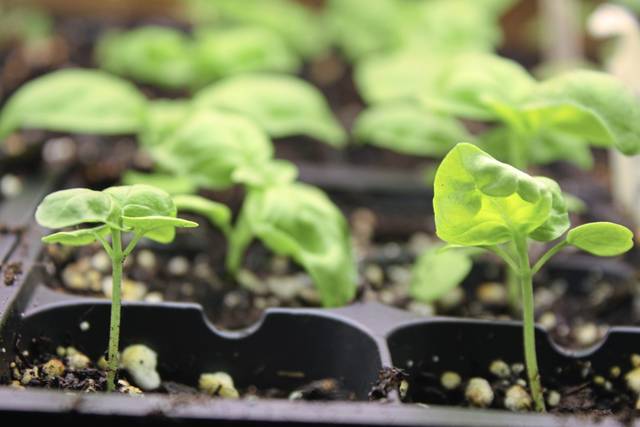3 ways to propagate herbs
I grow many herbs in my garden. I use them for cooking and for making my own herbal tea blends. While I do purchase herb plants from the nursery, I also try to save money by propagating my own herb plants. Thankfully, propagating most common herbs is easy. Depending on the species and its growth habit, herbs can be propagated in one of three ways.
Method 1: Seed
The good news is that most herbs are super simple to start from seed. Many annual herbs such as dill, chervil, cilantro, borage, and chamomile don’t need any coddling at all. Simply tossing a few seeds onto the bare soil as soon as the danger of frost has passed is all you need to do to grow a healthy crop.
Other annual herbs are a bit more fussy, requiring a jump start on the season by sowing the seeds indoors, under grow lights, four to six weeks before planting outside. These herbs include basil, parsley and sweet marjoram. Though they require a bit of forethought, they’re still very easy to start from seed by simply following the instructions on the seed packet’s label.
Perennial herbs, including lavender, oregano, sage, chives, tarragon, fennel, thyme and mint, require some patience if grown from seed, but if you’re willing to wait a full season before harvesting, it’s a great way to get started.
Method 2: Divisions
Most perennial herbs can also be grown from divisions of established plants. Find a neighbor, friend, or relative who grows these plants and ask them for a small division. Or, divide your own perennial herbs and share them with others or plant them in a new spot in your own garden. It’s good for the plants to be divided every few years.
Method 3: Cuttings
You can also propagate most perennial herbs by taking a few stem cuttings. Annual herbs can also be grown from cuttings, though most are so easy to start from seed it’s not worth the effort. Still, try taking cuttings of different types of basils; they’re an easy annual herb to experiment with. If you don’t have the herb you want more of already, you’ll need to find someone with an adult plant, then just follow these directions to root some of your own cuttings.
To root your own herb cutting, use a clean, sharp shear to cut off a terminal portion of stem containing two or three leaves and the growing point. It should be about 1 to 2 inches long. Cut off the lowest leaf and dip the bottom half-inch of stem into a rooting hormone (available at most garden centers). Insert cut end into a clean pot of new potting soil about 1 inch deep. The soil should be firmly around the plant stem. Water and let drain.
Place the pot into a clear plastic bag sealed with a twist-tie to keep the humidity high until the cutting forms roots. You probably won’t have to water very much while the plant is in the bag, but do water it if necessary. Place plant on bright windowsill (but not in direct sunlight) or under grow lights. Roots should form in four to five weeks. At that point, remove the plastic bag and any yellowed leaves. You can start fertilizing your new plant with compost tea or diluted fish emulsion when it’s about 8 weeks old.
Though the specific herb propagation technique I use depends on the plant species and its growth habit, it also depends on what time of year it is. Divisions of perennial herbs can be done in fall or spring. Cuttings of annual herbs can be done in the fall, overwintered indoors under grow lights, and then planted outdoors in the spring. You can take cuttings of perennial herbs in the spring, summer, or early autumn. Seed-starting is best done in late winter, if you’re starting them indoors under grow lights, or in spring, if you’re sowing the seeds directly into the garden.
Horticulturist Jessica Walliser is the author of several gardening books, including "Attracting Beneficial Bugs to Your Garden," "Good Bug, Bad Bug," and her newest title, "Container Gardening Complete." Her website is jessicawalliser.com. Send your gardening or landscaping questions to tribliving@tribweb.com or The Good Earth, 622 Cabin Hill Drive, Greensburg, PA 15601.
Remove the ads from your TribLIVE reading experience but still support the journalists who create the content with TribLIVE Ad-Free.

